
Sign in
Don't have an account with us? Sign up using the form below and get some free bonuses!

When my daughter was three years old, I didn't think anything about fostering childhood resilience when it came to Halloween. For some reason that's unbeknownst to me, she decided that what people do with Halloween candy is...donate it. Who was I to argue with her thoughtful idea? So, for the past two years, we've gathered up her loot and handed it off to a grateful recipient.
I somehow assumed that this is what she'd want to do with it forever. Yeah, just call me naive and we'll get on with things, shall we? In any case, we started Halloween today with our standard plan to donate her candy. She was completely on board.
So, off we went to our downtown "Safe Halloween" where local businesses open their doors to the kids and their parents for a couple of hours, doling out all the good stuff. Now, what makes the "good stuff" tricky for us is that my kiddo has food allergies, so donating her candy has always eliminated any risk to her safety. The Teal Pumpkin Project helps somewhat, but not everyone knows about it or chooses to participate.
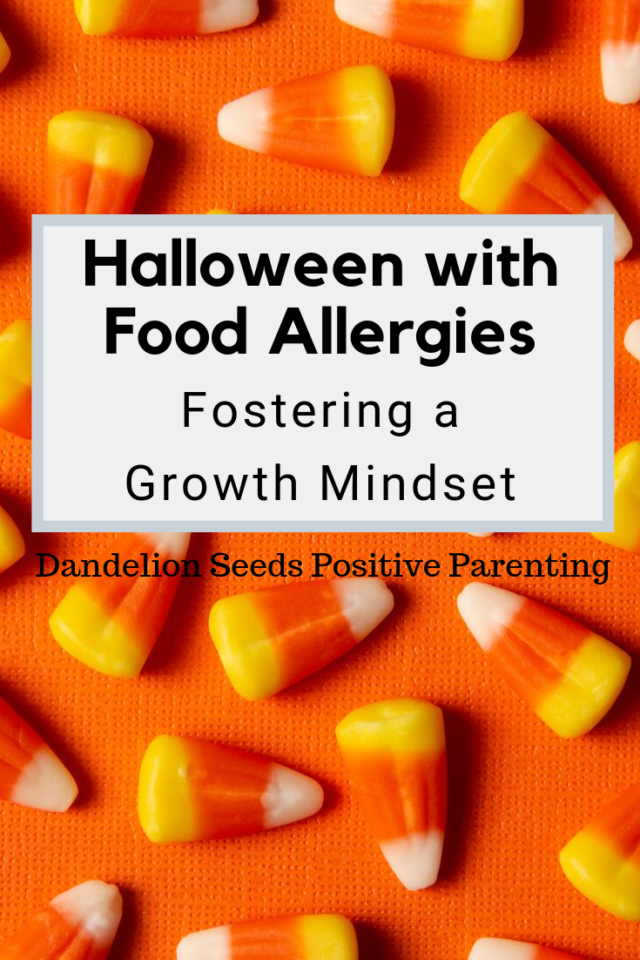
When we were done trick-or-treating, however, she crawled into the backseat of my car, opened her big paper bag, and took a quick whiff of the contents of the sugar-filled booty. I glanced back at her after another minute, and although her hands were still on the outside, her head had disappeared almost entirely into the bag. It smelled good. That's when I started to realize that this year might be
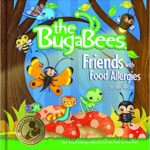
different. She might not want to donate the good smells.
When we got home, she inquired while holding up one of her goodies, "Mommy, can you please read the ingredients to this one?" Suddenly, I realized we were on a very slippery slope. What had been an easy fix to a problem wasn't going to work this year. Since reading The Bugabees (which I love for kids with food allergies), she's learned to ask what's in the food to which she's exposed. (Afflink) That's wonderful.
For better or worse, however, most commercial candies simply aren't options for her health-wise. To compensate for that, we have alternate "safe" treats at our house, usually healthy options. She'd broken off a square of dark chocolate during lunch at home just a few hours earlier as a special treat.
With all that in mind, I read the ingredients. She quickly self-identified that the candy she chose wouldn't work for her. And then she mourned.
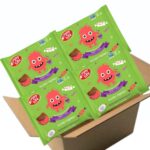
Empathizing, I told her, "I saw how much you really wanted that candy. The feelings I'm guessing you have right now are disappointment and sadness. You can tell me if I'm wrong." It helps kids to give names to feelings to help build emotional intelligence. Dr. John Gottman writes about this, along with a lot of other really insightful suggestions, in this book. It's best when children can name the emotions themselves, but that doesn't always work when they're emotionally flooded. She agreed that I'd guessed correctly.
After holding her and telling her I understood (truly, I do), I realized that this would be another teachable moment. I had to wait, of course, until her brain could find logic and reason, as this important book by Drs. Seigel and Bryson so clearly illustrates. One of the lessons I've learned, though, is that she learns best
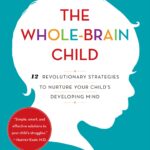
when I give her the space to solve problems for herself--while I fully support her emotionally along the way. This is a life skill she needs.
Knowing the rest of her loot would be similar, I offered, "I wonder what we could do to make the rest of the candy less tempting. Let's think about this." And then I waited, just a bit longer than where I felt comfortable. It's usually in that uncomfortable moment when she suggests something.
"I have an idea, Mommy."
"What is it?"
"Let's make it a science experiment. You grab a bowl and put some hot water in it; I'll put the candy in it and see what happens."
We proceeded to make a warm, gooey, good-smelling experiment while sitting in the middle of our kitchen floor. I hadn't thought of the idea. She had. And when she did, she bought in completely. We marveled at which ones floated or sank, and which ones bubbled (I'm never eating that kind again). She solved the problem in a way that will undoubtedly stay with her much longer than anything I'd have suggested, would have. And I believe she learned something about her own resilience.
Although I don't know if this candy-plan will work again next year, what I do know is this: she's capable of figuring it out. She's strong. I love that she has opportunities to see this.
_______________________________________________________
Click the images for details!




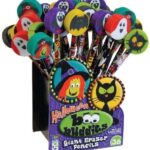

Most kids have inherently good negotiation skills. Pull out a chocolate bar and tell kids to divide it up for themselves, and you'll find quick proof of that. When it comes to conflict resolution and self-regulation, however, many adults wonder whether children possess the emotional intelligence and executive functioning skills to navigate that territory. As a result, many grown-ups are quick to intervene and solve social problems for them. After all, emotions are tricky even for us to manage, so it's tempting to guide our kids when we sense trouble. I know because I've done it.
I'll share an example of how much better it can work when kids figure out how to resolve conflict for themselves, however. When I was in a play-based science class with a group of four- to six-year-olds last week, they made "squishy circuits," where they connected two sets of wires, Play Dough, and mini-lightbulbs to the positive and negative ends of batteries in a particular sequence. If they connected everything correctly, the lightbulbs would light up.
Adults were there to help ensure the kids' safety, of course. (Personally, I'm thankful for observing Teacher Tom in action at another school I visit weekly. He's a world renowned teacher at a play-based preschool in Seattle. He's helped me chill considerably about what I consider dangerous for kids, and he facilitates conflict resolution better than any teacher I've ever seen.)
Once the kids got the hang of basic circuitry, they could get as creative as they wanted with their Play Dough inventions. One five-year-old girl who I'll call Catherine, who regularly displays high emotional intelligence and emotional self regulation, announced that she was going to use her Play Dough to make a kitty with a water bowl. Often demonstrating strong executive functioning skills, she's a "stick to the plan" kind of kid. (Executive functioning includes things like self-control, planning, and the ability to remember instructions. If you're looking for a deeper understanding of executive functioning and self-regulation, this article from Harvard's Center for the Developing Child describes them well.) So, she set to work right away while most of the other kids rolled their materials around haphazardly, deciding what to make.
After about 10 minutes, the girl next to Catherine, another five-year-old I'll call Mia, reached over and demolished Catherine's kitty. I've observed that Mia sometimes lacks the executive function skills to self-regulate. Looking flabbergasted, Catherine called me over to help resolve the conflict, announcing matter-of-factly what Mia had done. It was obvious. Catherine's blue Play Dough that Mia squashed was still in the center of Mia's palm. Mia had been using green.
Before I could say a word, Mia announced loudly, "I didn't do anything wrong!"
I felt tempted to call Mia out on her transgression and show my frustration. My first impulse was to ask her what the heck she was thinking. (I'm still learning and have to catch myself, too.) However, I know an objective tone is more helpful for encouraging honest dialogue. So, I took a breath and stated neutrally to both of them, "It sounds like something happened here." Mia has older siblings at home, and I know she's no stranger to managing conflict situations. I can't say with certainty, however, where she is on developing her executive functioning skills.
Dealing with conflict is a hard life skill to learn, because frankly, negative emotions are hard. I'm an adult and I still don't like conflict. We're not "wired" to like it. However, the ability to recognize someone else's point of view goes a long way toward developing emotional intelligence and self-regulation.
So, I continued.
Me, in a curious and non-accusatory tone: "Mia, I observe blue Play Dough in your hands. I'm feeling curious about that."
Mia: "Well, I did squash her kitty, but she had just started working on it. She didn't care."
Catherine: "I didn't just start working on it. I had been working on it the whole time! It was important to me."
Me: "Hmmm. Catherine, I hear you saying that it was important to you."
Being an active listener, including playing back what you've heard, is a key ingredient in helping kids resolve conflicts. It shows that you're internalizing what they said, and essentially invites them to continue while feeling supported. Accusation is counterproductive; only when kids feel supported can they grow their emotional intelligence effectively.
And as is true with many things, when it comes to engaging in kids' conflicts, less is more. Less adult talking is more beneficial to kids learning to solve problems on their own. When they feel capable of doing that, it reinforces growth in the self-regulation and executive functioning parts of their brains.
Catherine and Mia continued without prompting.
Catherine, addressing me: "I really didn't feel so happy when she did that."
Mia, to Catherine: "No, you were happy."
Catherine: "No, I really didn't feel so happy when you did that."
Mia: "Oh." Mia's eyes went downcast then with apparent remorse, and perhaps with understanding the deeper connection between emotions and behavior.
At that point, they sat together silently, in what seemed to be somewhere between an impasse and emotional connection. I paused for long enough that I was sure each had finished saying her piece. When neither continued, I suggested next steps without solving anything for them, similar to creating a negotiated agreement in a boardroom.
Me: "I'm going to guess that nobody in the room likes getting their Play Dough squashed. I'm wondering if that's true."
Both girls, agreeing: "Yeah. No one should squash Play Dough."
Me: "Okay, then. I think you've solved a problem. Since no one likes getting their stuff squashed, I wonder if we can agree not to squash anyone else's stuff, either." (I essentially played back the solution they'd reached, just broadening it slightly.)
Both girls, nodding vigorously: "Yeah. Let's do that. No squashing people's stuff!" I could almost see the self-regulation synapses connecting in Mia's brain. Moreover, Catherine's emotional intelligence was growing by having expressed her frustration in an appropriate way. She felt "heard" and could move on. Her emotions had no reason to escalate. Executive functioning in action.
All of us: Exhale. Resolution. Consensus.
Both girls seemed resolved in the matter. Their conflict was now water under the bridge. They moved forward happily with their projects.
I fully trust that their self-identified conflict resolution did far more for their executive functioning skills than any punishment or forced apology could have.
And the sooner we let them try, the better. Studies show that practice between the ages of three and five is particularly beneficial. This is also the age that their working memory develops in leaps and bounds, so that they'll have specific experiences upon which to draw as they get older. Areas of the brain that develop during this timeframe are profound and substantially important for future interactions. Some would argue that the ability to self regulate and strong emotional intelligence skills matter far more than IQ alone.
Socially skilled kids can focus attention on managing conflict and growing their relationships with peers. It's possible because they already have the emotional intelligence and self-regulation tools in place to do those things. Conversely, those with executive functioning issues need more practice. The adults in their lives will support them best by resisting the urge to dive in and rescue them when they see any type of conflict; but rather, by letting them attempt their own conflict resolution, even if they get it wrong. Practice makes perfect, right? Our presence is beneficial and sometimes necessary, but our words should be few.
Maybe emotions are tricky for adults to manage because some of us didn't get enough practice when we were kids. I don't know. What I do know anecdotally, however, is that emotionally intelligent kids usually grow up to be emotionally intelligent people (adult-sized, because, of course, kids are people, too). The ability to understand and manage emotions, resolve conflict, and display emotional intelligence is a lifelong gift to ourselves and those around us.
_____________________________________________________________
Follow Dandelion Seeds Positive Parenting and Dandelion Seeds Positive Wellness on Facebook. We’re also on Instagram at DandelionSeedsPositiveLiving.
We appreciate your support! Click here to see all the children’s books, parenting books, toys and games, travel necessities, holiday fun, and wellness-related items that we’ve used and loved. As an Amazon Associate, I earn from qualifying purchases. However, pricing (including sale prices) and shipping are still from Amazon. Once you click the checkout button from your Dandelion Seeds cart, it’ll direct you to Amazon to complete your purchase.
"Mommy, let's pretend this isn't a train tunnel."
"Okay, what is it?"
"It's a tomb."
Well, hello, conversation stopper. She paused for effect, which is a good thing, because I certainly didn't expect that. After a moment to process and very consciously trust that children's play serves an important purpose for them, I mentally cringed while inquiring, "Is anyone in there?"
"Yep, a dead person."
She smiled lovingly at me, just content to be playing.
I have to admit that this already wasn't my favorite game, and although I didn't know who was inside, I was hoping for some miraculous resurrection of sorts.
"Was it anyone we know?"
"Nope, it's not. It's just some man. He's dead in there."
Well, at least it's no imaginary person we know. Somehow that made it better for me, the adult who should be able to handle a child's imagination.
Still, I waited for the punchline and trusting her play, looking for some clue as to where this was going.
"What happened to him?" I asked tentatively.
"A cow sat on him. And then a car drove on top of the cow."
Well, that would certainly do it. Although she knows bodies stop working when someone dies, we haven't spent much time discussing the specific mechanics of the process.
Then, she added, "Yeah, he was really, really old, like Grandpa Herb."
Click. Now, I see what's happening. Grandpa Herb is actually my grandfather; her great grandfather. As I write this, he's a 95-year-old with a body that's more ready to go than his brain is.
I reminded her that Grandpa Herb is still alive, but she proceeded me to remind me that he's "really, really old and probably won't live much longer."
He might have another decade ahead of him, but he might not. She's bright enough (as kids are) to pick up on pieces of the adult conversations to know that we talk about his life and medical situations differently than we do others'.
Just like we do as adults, kids need to process when change is coming; especially when it's such an abstract concept as this (for all of us). We rarely discuss death with children unless it's necessary, so it's particularly foreign to them when it happens. We can read helpful books like this one and this one (afflinks) to help cover the bases. I can trust that her play is helping her process just as she needs to. And she can ask all the questions she wants to, and I'll do my best to answer them according to our belief system. Of course, I can't tell her what dying is like, though, because it's never happened to me.
So, until then, we find ways to make peace with the unknown. We need to somehow make the intangible, tangible. We need to know that when the time comes, we'll have done something to prepare, because we all want to do something.
Some might call this "game" macabre and make that resurrection manifest somehow, or insist that it's a train tunnel and nothing more. For us, it became a way to process and discuss one of life's Big Topics, using the means my child knows best: learning through play. It's within her power to play; the more she can process it in her own terms without me imposing my agenda on her, the more she can begin to grasp and reconcile the concept. And the more she can be ready for the inevitable, be it for Grandpa Herb or for a goldfish, the less jarring it will be for this child.
Personally, I'm going to beware of sitting cows for awhile. More than that, however, I'll continue to trust that play needs to happen, exactly as it is.
Knowing her grandparents will soon be asking for gift ideas for our daughter, my husband and I decided to take our five year old window shopping today. As usual and as I've written about before, we began with the caveat that although we wouldn't buy anything, we'd take pictures of what she likes so that we're sure to remember. This approach has pretty much been golden for us since she was two, and learning to delay gratification has contributed well to her growth mindset.
Today, however, she was really short on sleep. Even for me, an adult, a lack of sleep thwarts even the very best laid plans. Still, we pursued our endeavor to leave the house.
Upon entering the store, our child uncharacteristically said, "I've decided we're not just going to look at toys. We're going to buy some for me today to take home." I gently and clearly reminded her of our mission. And I hoped for the best.
We made it past the greeting card aisle and into the craft aisle. On display with the crafts, they were selling a sewing machine for kids. She picked it up and announced, "This is what we're buying for me today. Let's go check out now."
I wish I had a dime for every time I'd seen a parent in a similar predicament. I'd be able to buy a thousand sewing machines. Regardless, this was really unlike her.
I acknowledged how much she wanted it and reminded her that we'd put it on her list. I took a picture of it, and for good measure, so did my husband.
She announced that she would carry it through the store with us until it was time to check out, and then we'd buy it. I let her know that she'd be welcome to carry it through the store, but that we'd put it back on the shelf before leaving. Setting expectations upfront usually does wonders for keeping things mutually agreeable. However, the "mutually" wasn't happening here today. So, I presented it as a loving limit and took the time to discuss and validate how she felt.
Sure enough, she chose to carry it through the store, anyway. She had no interest in looking at any other toys. We stopped to look at some decorations and at a few items for my husband, but that was it. She wanted to go no farther, though, so we returned to the craft aisle, the sewing machine still firmly in her grip.
We had nowhere else to be, so we did a bit of emotion coaching to help her. However, it was still a no-go for her. She said she'd wait there "forever" until we bought it. Taking it from her forcefully would do nothing for her emotional intelligence, our connection, or her growth mindset. So we waited, letting her feelings be what they were, and trusting that this was temporary.
After awhile, I asked her to think of a way she'd be willing to leave it at the store. Because she wasn't in an emotional place to think logically right then, I offered her the options of either putting it back right away or walking toward the exit while she held onto it, until we reached the checkout area. At that point, her option would be to hand it to my husband to put back before we reached the door. She chose the latter. And for whatever reason, she quickly put the sewing machine back on the shelf where it belonged. However, she grabbed a unicorn craft that was nearby and held onto it just as steadfastly.
However, near the checkout area, she changed her mind and wouldn't relinquish it. At that point, I shared a story with her about a time when I was little and didn't get a toy I wanted. Her demeanor changed. She softened. For the first time in awhile, she looked me in the eyes and connected. She felt understood.
Shortly thereafter, she offered, "I don't want to put it back on the shelf. I want to put it somewhere...else."
I replied, "It's too hard to take it back to the craft aisle. You want to put it somewhere different."
"Yes. I want to hide it and see if Daddy can find it."
Fortunately, because she's five, her hiding places often include instructions such as, "Please don't look behind the chair."
She looked resolved, proud of having solved the problem herself. All she needed was the time and emotional support to do it. So, off we set on a short mission to find the perfect hiding place for it. After testing a few options, she settled on setting it between the feet of a mannequin. She promptly informed her Daddy not to look there. (Daddy, of course, returned it to its proper place once we were out of sight, and she confirmed later that it was exactly what she'd wanted him to do.)
And off we went to the car; her, sad but accepting, growing in her ability to solve problems. Even among the shiny objects; even when sleep deprived, she found a way to do it that was mutually agreeable. We can both sleep well tonight.
Every week, I help teach a dance class. And every week for the past three months, six-year-old Lexi (not her real name) has had to be first in line when the children await their dance props (scarves and whatnot). When it's time to line up, she'll push other kids out of the way to get the prime spot. When she's dancing on stage and someone has a more desirable position than hers, she'll inch her way into the other dancer's space, slowly edging her out until she's right where she wants to be. Some of this can be very normal in child development. It's frustrating at times and certainly not how all kids develop, but normal for some children, nonetheless.
And up until last Monday, the kids in dance class had been finding ways to coexist with her without too much strife. I chalked it up to the world needing both leaders and followers. Some people are just a bit trickier than others.
Last week, however, Lexi was particularly rough when barreling over some of the other girls. This time, they didn't like it. And the more they tried to work with (and around her), the more determined she became.
Try as I might to stay patient and let them work it out, I was getting frustrated with this girl.
When I'm busy with a lot of kids, it's sometimes hard to remember that children usually know exactly what they need. They often know what would help remedy their undesirable behavior. Fortunately, I saw the struggling child in front of me, along with the opportunity to facilitate. So, I pulled her aside, hoping she'd take a shot at figuring out how to be fair to the other girls.
At first when I tapped her on the shoulder and asked her to leave the stage with me for a moment, she furrowed her brow and crossed her arms, clearly in a defensive posture. She followed me, and we sat side-by-side on a stair. Starting with a problem statement, I told her, "I'm seeing lots of sad faces on lots of girls today. It seems that many of them want to have a turn being first in line."
I continued, "I wonder what we could do to keep it fair for everyone. Let's talk about some ideas."
Observing a wave of relief wash over her when she realized I was engaging her peacefully, she replied, "Oh, I know! We could make a list of everyone's names and then take turns, going down the list, to see who goes first."
Smiling, I told her I thought that seemed really reasonable.
And then I promptly ruined the moment by saying something about the "need to be fair" in a way that she could have perceived as condescending, which was exactly the opposite of what I hoped to do. Grrr. I felt instant remorse, but it was too late.
She continued just as she had before, pushing and clamoring over others to be first.
I heard myself wonder more than once, "What in the world is going on with her?"
As I've written about before, expert Kelly Matthews of A Place for You Early Childhood Consulting suggests (and as she learned from her mentor, Deb Curtis), “Don’t get mad, get curious.”
I'm decent (not perfect, but decent) at "getting curious" when it's my own child, but I'd forgotten this sage advice in a busy room full of movement and noise. Fortunately, that wisdom returned to me while I still had another chance to try it.
I pulled Lexi aside again. Her demeanor wasn't much better than the first time I'd done it. I don't blame her. But I stated factually, "It seems like something is hard for you today. I'm here if you'd like to talk about it."
And this time, she sat me down on the stairs, girls moving all around us. She seemed oblivious to them. She proceeded to tell me how she "never" gets to be first for anything at home: she has an older brother, and "he's the meanest". In her words, he never lets her do anything, and her parents always side with him because he's older and "knows more." She reinforced how hard that is before adding that she was missing her Mom.
I sat quietly, listening.
She continued that her Mom has been gone for awhile, visiting her Grandma far away. And her Grandma is dying. And she doesn't really know what that means, but she knows she misses her Mom and doesn't know why she can't come home to be with her.
On she went, citing all her very real troubles. Suddenly it made perfect sense why she was acting out here in class.
Understanding children's behavior happens best when we connect with them. When she was done sharing her story, I simply nodded, said I understood, and asked if she'd like a hug. She said yes. And then she wanted another. After that, she ran off, back to the group, and then out the door as class was ending.
For the next week until class met again, I wondered about her.
And then it was class time again.
I said nothing. However, I made sure to smile and go out of my way to say I was glad to see her. She told me about her new loose tooth (it's her first one!).
I observed that every time the girls lined up at the wall, she put herself third in line. Always exactly third. She didn't push anyone or do anything that would cause a teacher to raise an eyebrow.
So, at the end of class, I tapped her on the shoulder and said, "Hey, I wanted to let you know I saw how hard you worked to keep class fair for everyone today. You let others go first. I see the effort you made. Thank you so much."
She smiled sincerely and added, "Yes, and I even offered my purple dancing scarf to another girl who I know likes purple, even though it's my favorite color!" She switched from smiling to all-out beaming, proud of herself. As she should be.
I get a lot of things wrong, but I do my best to assimilate what I've learned from other wise parents and teachers. I don't take credit for anything here--all I did was listen to Lexi. It's the simplest idea; the simplest way to connect. And as it turns out, that's exactly, and all, she needed.
*
Update: Three more weeks have passed. She runs up to me and says hello every time she sees me. Her tooth is still loose, and her cooperation in class continues to be stellar (with no prompting whatsoever). Connection works, friends. I'm so proud of her.
I was just waking up and remembered that I needed to move some food from the night before from the refrigerator to the freezer. Upon opening the fridge, I noticed that the lid on the food wasn't secure, so I tried to push it down. In doing so, my Superheroine-Like Muscles (that must be it, right?) managed to push down the entire shelf. Half the food went airborne and the other half, along with the shelf, came crashing down like an avalanche. That's one way to wake me up!
Some of the food flew far enough to land on a Magna-Tiles creation (afflink) that my daughter had made. Now, unlike many kids who assemble and dismantle toys as often as they blink, my child, who's a self-proclaimed engineer, will painstakingly plan and build her creations, adding to them over weeks and months until they're "just right." She develops intricate stories about the imaginary people living in her elaborate villages, and if I didn't know better, I'd think they were really there.
So, when the Food Monsoon came through and damaged her village, she was devastated. 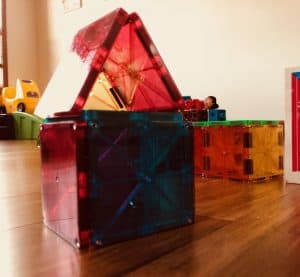
I was still tired and a bit grouchy. The chaos I'd created before having my morning tea didn't help matters. Rather hastily, I instructed her to back up while I cleaned the mess. I wasn't thinking about the effects on her Magna-Tiles; I just wanted to get the food off the ground as quickly as possible.
Hot on my heels, she followed me to the utility room to get the cleaning supplies. I barely noticed she was there until I heard the distinct sound of a muffled sob. She was trying to let me work, but her sadness was finding its way out.
Only then did I see her. I knelt down despite my frustration and, still in my rational adult brain, I hugged her and told her calmly that I just needed to clean up and then we could get ready for breakfast.
Woah, Nelly. Not so fast.
"But Mommy," she struggled to say through an increasingly reddening face, "What about the family who lived in the house I built?"
Oh, right. The family. There were (imaginary) people in there. Still not "getting it," I replied softly, "Let's make the houses again together as soon as the materials are clean."
I needed to wake up. It wasn't the loss of the houses she was mourning; it was the people. The people she'd imagined; the people she'd grown to love in perfect childlike endearment.
Finally, I got it. I had to get out of my adult brain and address it from the perspective of a five-year-old. I know better than to "solve" problems as I'd been trying in my haste; she needed me to actively listen and to see her.
"I hear you're really concerned about the people," I started, "and you're worried they won't have a place to live."
Cue the big sobs. I'd hit the right nerve. The tears came heavily then and lingered for a long while; her heart weighed down with a child-sized natural disaster. It was completely real to her, as it should be. That's how kids' brains work.
"Yes, Mommy! What will they do?"
Finally connecting as I should have since the beginning, I replied, "I hear your deep concern for the family. You really care about them." Without attempting to solve her problem, I listened. I held her as she mourned and processed her feelings. After she'd allowed her storm to pass, she regained a sense of calm. Rushing her or reassuring her that she was alright (when she didn't feel that way) would've invalidated her experience. Listening empathetically as she worked through her sadness allowed her to build resilience, along with fostering trust in herself that she can get through hard things.**
At this point, still fully entrenched in her imagination and worry, she looked to me for guidance. The best way to connect with her in that moment was to join her right where she was: understanding her imaginary people's needs. She needed to play it out.
When she was ready for problem solving but too emotionally spent to suggest something on her own, I offered, "I want to you to know something important. I'm not sure if you saw it last night, but the family left a letter for us. It said they were going on vacation and that they wouldn't be at home today. They were planning to have some renovations done to their house and knew it would have to come down for awhile, so they were going camping in the other room. They were planning to sleep under the stars on top of your trampoline."
She blinked at me.
"But Mommy, couldn't they just sleep under the trampoline if they wanted to be in the dark? I think that's what they would want to do."
I agreed that, oh yes, it would be darker under there. That's likely what they did, and I told her so. Her mood instantly lifted.
She needed to know that I "got it" and could reassure her in her terms, not mine, that all would be well with the world again.
After all, when bad things happen to good people, isn't that what we all want?
__________________________________________________
** This is a helpful book for learning how to support your kids' emotional intelligence. To see all the cooking, child-, and parenting-related items that have stood the test of time in my house, including my favorite books, click here. As an Amazon Associate, I earn from qualifying purchases.
A couple of weeks ago, my four-year-old child was looking admiringly at the cover of a Cinderella coloring book. She's had it for half her life. Until now, she'd always been more interested in the scenes overall than in the individual princesses. And she's certainly never addressed anything about her body image. This time, however, she matter-of-factly announced, "Mommy, this girl is the most beautiful girl in the world. I'm not that beautiful."
I paused, with a sinking feeling in my gut, to absorb the news that the inevitable had happened. My child was comparing her looks to others'--even if the "other" was Cinderella--and finding hers inferior. Her tone was one of factual observation more than one of self-deprecation. However, I knew it was the precursor to what women everywhere are up against: the pressure to look whatever way society thinks is beautiful. People judge us on our appearances alone; people who don’t even know us, much less love us.
This mama's wish--and the wish of nearly every other mama I know--is that our children would live in a world that rises above that mentality. With my heart in my stomach, I took a breath before responding. Doing my best to summon everything I've studied about respectful parenting as it relates to body image, I neutrally responded, "Baby girl, that's interesting. Tell me more."
She proceeded to tell me everything she found lovely about Cinderella. When she finished, I acknowledged her closing statement with "Yes, I like the color of her dress, too." I continued, "Do you know what I really like, that you can’t see in any picture? In fact, I think it's what makes someone truly beautiful, more than anything else could."
"What is that, Mommy?"
"Kindness. Some people say it's nice to look a certain way on the outside, but kindness is the greatest kind of beauty. It has nothing to do with what someone looks like. Unlike appearance, which changes over time, kindness can last someone's entire life."
"Oh."
I could tell she was processing thoughtfully. We lingered on the topic for only a few moments more. I was careful to avoid giving the topic of external body image too much attention, lest it become a priority in her mind. As a mom, positive body image is one of the issues that I really need to own and model, and that I really want to get right for my child. It's a tough one for many of us.
After that, weeks passed without another mention of beauty. Yesterday, however, she approached me, holding the brooch of one of her dress-up gowns. On the brooch was a picture of Cinderella. I wondered what was coming.
My heart swelled with joy. Indeed, physical beauty and body image will be on my daughter's radar if she's anything like most of the women in generations before her. And she may or may not grow up looking anything like a princess, but that's not important to me.
Hard as it had been not to tell her how beautiful I think she is, I knew the importance of acknowledging what she said without negating it.
As a woman and particularly as a mother, this has been a tough lesson to learn. I have, however, learned that when I actively listen, be it about princesses or anything that's important to her, it helps foster our connection and build her confidence that she can trust me with her innermost thoughts.
So, I listened to her and added to her understanding, helping her unwrap her feelings. I wanted the opportunity to make a positive impression on her value system. The most effective way to do that is by listening to her with an open mind and guiding her appropriately. Loving and intentional guidance works so much better than telling her she's wrong.
We really can influence children’s thought processes and body image respectfully while still supporting their inner princesses—or superheroes—whoever they may be. We can help them absorb what really matters. And that, my friends, is beautiful.
_____________________________________________________________
Follow Dandelion Seeds Positive Parenting and Dandelion Seeds Positive Wellness on Facebook. We’re also on Instagram at DandelionSeedsPositiveLiving.
We appreciate your support! Click here to see all the children's books, parenting books, toys and games, travel necessities, holiday fun, and wellness-related items that we've used and loved. As an Amazon Associate, I earn from qualifying purchases. However, pricing (including sale prices) and shipping are still from Amazon. Once you click the checkout button from your Dandelion Seeds cart, it’ll direct you to Amazon to complete your purchase.